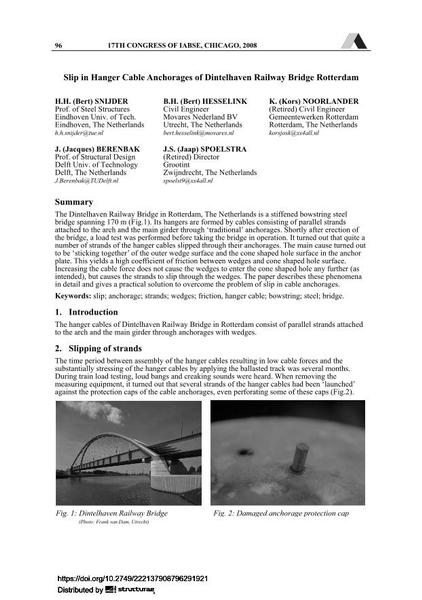Slip in Hanger Cable Anchorages of Dintelhaven Railway Bridge Rotterdam

|
|
|||||||||||
Bibliographic Details
| Author(s): |
H. H. (Bert) Snijder
Bert H. Hesselink K. Noorlander Jacques Berenbak J. S. (Jaap) Spoelstra |
||||
|---|---|---|---|---|---|
| Medium: | conference paper | ||||
| Language(s): | English | ||||
| Conference: | 17th IABSE Congress: Creating and Renewing Urban Structures – Tall Buildings, Bridges and Infrastructure, Chicago, USA, 17-19 September 2008 | ||||
| Published in: | IABSE Congress Chicago 2008 | ||||
|
|||||
| Page(s): | 96-97 | ||||
| Total no. of pages: | 8 | ||||
| Year: | 2008 | ||||
| DOI: | 10.2749/222137908796291921 | ||||
| Abstract: |
The Dintelhaven Railway Bridge in Rotterdam, The Netherlands is a stiffened bowstring steel bridge spanning 170 m. Its hangers are formed by cables consisting of parallel strands attached to the arch and the main girder through ‘traditional’ anchorages. Shortly after erection of the bridge, a load test was performed before taking the bridge in operation. It turned out that quite a number of strands of the hanger cables slipped through their anchorages. The main cause turned out to be ‘sticking together’ of the outer wedge surface and the cone shaped hole surface in the anchor plate. This yields a high coefficient of friction between wedges and cone shaped hole surface. Increasing the cable force does not cause the wedges to enter the cone shaped hole any further (as intended), but causes the strands to slip through the wedges. The paper describes these phenomena in detail and gives a practical solution to overcome the problem of slip in cable anchorages. |
||||
| Keywords: |
steel bridge anchorage friction strands hanger cable bowstring Slip wedges
|
||||
